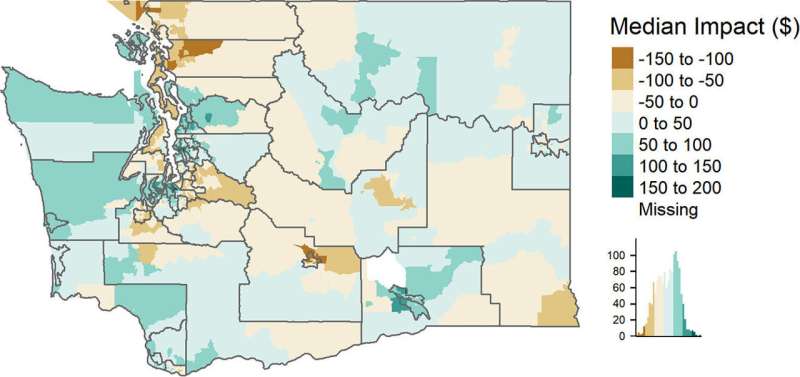This article has been reviewed according to Science X's editorial process and policies. Editors have highlighted the following attributes while ensuring the content's credibility:
fact-checked
trusted source
proofread
Researchers develop new method to assess equity implications of carbon taxes

Researchers from the University of Massachusetts Amherst and Smith College have developed a new method to assess the equity implications of carbon taxes, which are among economists' favored solutions to address the looming threat of climate change.
The method, which uses spatial microsimulation (SMS) to generate granular household-level estimates using aggregate statistics, is able to provide more detailed insights into the distributional consequences of carbon taxes compared with relying on averages to predict the effects on a given population.
Nathan Chan, associate professor of resource economics at UMass Amherst, and Susan Stratton Sayre, associate professor of economics at Smith College, employed SMS to assess the impacts of Initiative 732 (I-732) in Washington state. The initiative would have established a new carbon emission tax on certain fossil fuels—and electricity generated from them—while cutting the sales tax and creating a tax rebate to mitigate the effects on lower-income working families.
The study found that, while the rebate would have provided substantial benefits for many lower-income families, the new tax would still have cost a considerable number of households hundreds of additional dollars each year—and delivered savings to upper-income households in the form of reduced sales taxes.
"A major stumbling block for carbon tax proposals has been the concern that they will exacerbate income inequalities—though there historically has been little clear evidence to support that," Chan says. "The prevailing method for understanding these policies has used averages for geographic areas, but that omits much of the variation that matters. Our method using SMS provides the detail required to understand the distributional consequences."
To analyze the effects of I-732, Chan and Sayre constructed a synthetic population for the state of Washington and then projected carbon consumption for each household in that population. Consistent with conventional thinking, they found that for rebate-eligible households, the effects of the tax were largely mitigated. However, the study identified other low-income families ineligible for the rebate due to their working status who would have been negatively affected.
In addition, the study found that, contrary to popular belief, the carbon tax would not have put an outsized burden on rural households. In fact, the largest burden would have been shouldered by families in the suburbs and exurbs of major metropolitan areas—people who commute long distances to work in Seattle, for instance.
Further, the results show the sales tax cut (from 6.5% to 5.5%) wasn't deep enough to completely mitigate the carbon tax for low-income households—but it did produce savings for wealthier families who purchase more goods and services.
"Sales taxes are known to be fairly regressive, so one might think that cutting a regressive tax would be progressive," Sayre explains. "But it turns out, it wasn't progressive enough, and higher-income households would get more savings from the sales tax reduction because they spend more money."
Ultimately, Washington voters rejected I-732 in 2016 and a similar proposal two years later, but the SMS model developed by Chan and Sayre can be adapted to analyze carbon tax policies virtually anywhere by adding local demographic and energy market data.
"We hope this study informs future local, state and regional carbon tax initiatives," Chan adds. "Policymakers should be analyzing the data in advance to figure out whether their proposals will have the intended outcomes and to allay concerns about equity and distributional consequences."
The complete paper, "Spatial microsimulation of carbon tax incidence: An application to Washington State," will be published in the July 2024 edition of the Journal of the Association of Environmental and Resource Economists.
More information: Nathan W. Chan et al, Spatial Microsimulation of Carbon Tax Incidence: An Application to Washington State, Journal of the Association of Environmental and Resource Economists (2024). DOI: 10.1086/727476
Provided by University of Massachusetts Amherst





















